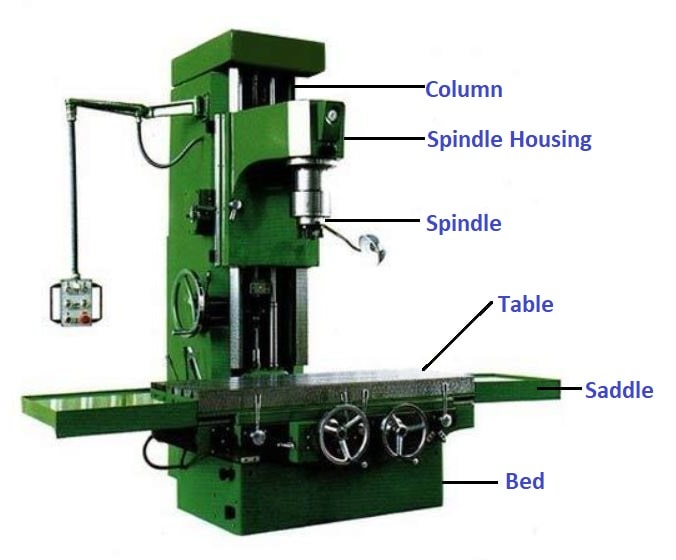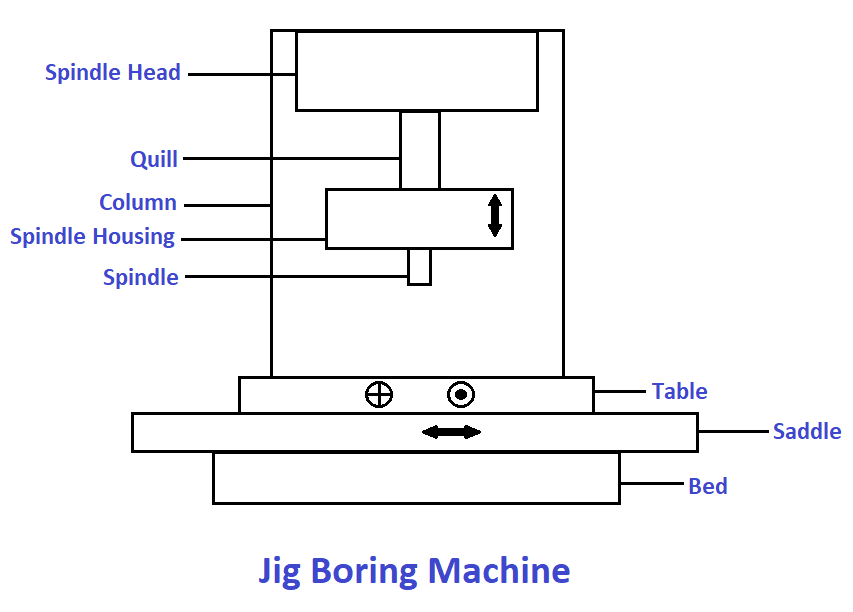In this post, you’ll learn what is Jig Boring Machine. With Its Working Principle, Parts, Types, Operations, and Applications of jig Boring Machine.
Jig Boring Machine
The jig boring is the most accurate machine of all machine tools. This was first developed in the year 1910 in Switzerland and used as a locating machine. The real jig borer was first built in the year 1917 by Pratt and Whitney.
Jig boring machine is used for the production of jigs, fixtures, tools, and other parts. That requires a high degree of accuracy. They are defined by terms of highest accuracy through rigidity, low thermal expansion, and precise means of measuring distance for locating and spacing holes.

The machining accuracy is high, within a range of 0.0025 mm. A jig boring machine looks like a vertical milling machine. But so far its operation and accuracy are concerned that there cannot be any comparison between the two.
The spindle and other parts of the machine are much hard to resist deflection and the vibration is low. A Spindle runs in preloaded antifriction bearings. The spindle housings are made of invar having a very low coefficient of linear expansion.
Jig boring machines need to be operated in temperature-controlled rooms where the temperature can be kept constant. This is essential to prevent inaccuracy in the machine and in the work being manufactured due to the thermal expansion of the metal.
Parts of a Jig Boring Machine
Following are the parts of a jig boring machine:
- Head-stock
- Column
- Bed
- Pick-up devices
- Table and saddle
1. Head-stock
It is also called the spindle head, it is fixed on the column in the front. The spindle is held in the shaft. As this shaft is moving upward and downward it becomes more like a telescopic mechanism.
2. Column
It is also a hollow component made of cast iron. It is supporting the headstock, guideways and vertical head gives axis for positioning.
3. Bed
The tools on which the machine is grounded is called a bed. It is made of cast iron which supports the pillar, saddle, control penal, and the whole machine.
4. Pick-up Devices
It is connected to the table and saddle. It is helping to control various machine operations automatically.
5. Table and Saddle
The table helps to fasten and hold the workpiece in a fixture in the required position. So it has T-shaped slots built into it. The saddle gives the longitudinal motion to the workpiece.
Working Principle of Jig Boring Machine
Jig boring machine works on the principle of feed in the vertical axis of the hole and its radius. In this process rotating tool is moved over the process is given with respect to static work.

This principle is used for large workpieces. Whereas the small size workpiece tool is kept stable and the work is done by applying force. Jig boring is a unique type of boring process. So its working principle is similar to the boring process.
Types of Jig Boring Machine
There are mainly two types of jig boring machine:
- Vertical milling machine type
- Planer Type
1. Vertical Milling Machine Type
It relates in construction to a vertical milling machine. The spindle rotates on a vertical column and the horizontal table rests on the bed in front of the column.
The position of the work mounted on the table. It may be taken by compound moves of the table, perpendicular, and parallel to the column face.
2. Planer Type
It has two vertical columns on the two sides of the table and is fixed on the base. The table has a reciprocating action for adjustment of the work. The spindle is fixed on the crossrail bridging the two vertical columns.
In a planer type jig borer, two co-ordinate movements for hole location are given. By the longitudinal movement of the table and the cross movement of the spindle along the crossrail.
Methods of Locating Holes In Jig Boring
Holes should be bored on jigs and fixtures at distances from the two straight sides of the work. Exact positioning is essential for producing accurate jigs, fixtures, dies, etc.
The most important operation in a jig boring machine is the perfect way of positioning a hole. The perfect way of locating a hole in a jig boring machine may be secured by any one of the following methods:
- Leadscrew method
- Mechanical and electrical gauging method
- Optical measuring method
1. Leadscrew Method
The leadscrew method is the most common and quick method of placing the work below the spindle.
Both longitudinal and crossfeed leadscrews are rotated by a specified value. Any error in the leadscrew due to backlash, wear, or manufacturing fault may be set by using a compensating device.
2. Mechanical and Electrical Gauging Method
Mechanical gauges such as gauge blocks or end measures are placed against a stop on the table. And a dial indicator is fitted at the outer end of the trough.
The motion of the table is now directed by the length of the end measures. The table may be set both in a longitudinal and crosswise direction to locate the exact hole. Electrical gauging devices are also sometimes used.
3. Optical Measuring Method
The scales used for measuring the motion of the table are enclosed within the machine to stop it from any harm or wear.
The motion of the table is set by the leadscrew or by hydraulic means. But the position of the table along the two axes is done by using the scale which may be seen through a microscope.
Specification of Jig Boring Machine
Following are the specification of jig boring machine:
- It has a maximum distance between the spindle face.
- The distance of the spindle axis from the column.
- The minimum distance between spindle, face table & various spindle speeds.
- Least count of vernier caliper.
- The minimum measuring capacity of a dial.
- Horsepower of the table feed motor.
- Horsepower of the main motor.
- A maximum table transverse.
- The dimension of the working axis of the table.
- A maximum weight of work which can be placed.
Jig Boring Operations
The jig boring machines are made to produce precision dies, gauges, and jigs. They can also be used as a measuring machine to check up a job already manufactured in other machines.
Workpieces are clamped on the table by T-bolts and straps. And single point boring tools are used for enlarging holes. Single-point tools are favored than multipoint tools. As a single point tool allows maximum accuracy in locating holes and offers a better surface finish.
Applications of Jig boring Machine
Following are the applications of jig boring machine:
- The jig borer is used for the pilot hole.
- It is used to make compound and progressive dies.
- It is also used for drilling holes in jig-bushing.
- Jig borer is commonly used for jigs, fixtures and dies & bushing hole for grinding & A grinding the hardened parts.
- Also used in alignment post in stripper or die set.
Conclusion
So now, we hope that we have clear all your doubts about Jig Boring Machine. If you have still any doubts about the “Jig Boring Machine” you can contact us or ask in the comments.
We have also a Facebook community for you guys. If you want, you can join our community, here is the link to our Facebook group.
That’s it thanks for reading. If you like our article then please share it with your friends. If you have any questions about any topic you can ask in the comment section.
Subscribe to our newsletter to get notified when we upload new posts.
You may be interested in reading this articles:
- Different Types of Milling Cutters
- Broaching Machine: Types, Operations & Advantages
- Slotter Machine & 4 Different Types of Operations
Image Source: Indiamart.com